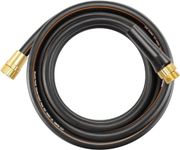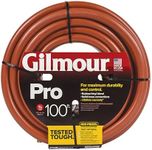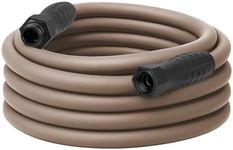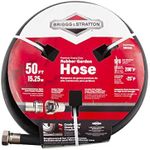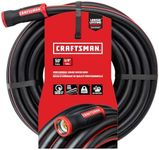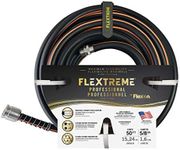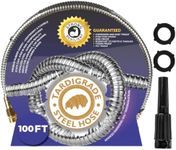Buying Guide for the Best Rubber Garden Hoses
Choosing the right rubber garden hose can make your gardening tasks much easier and more efficient. A good garden hose should be durable, flexible, and suitable for your specific needs. When selecting a rubber garden hose, consider the following key specifications to ensure you get the best fit for your gardening requirements.LengthThe length of the hose is crucial because it determines how far you can reach with it. Garden hoses typically come in lengths ranging from 25 to 100 feet. If you have a small garden or patio, a shorter hose (25-50 feet) might be sufficient. For larger yards, you may need a longer hose (75-100 feet) to reach all areas without having to move the hose around too much. Consider the size of your garden and the distance from your water source to the farthest point you need to water.
DiameterThe diameter of the hose affects the water flow rate. Common diameters are 1/2 inch, 5/8 inch, and 3/4 inch. A 1/2 inch diameter hose is suitable for light watering tasks and small gardens. A 5/8 inch diameter hose is the most versatile and commonly used, providing a good balance of water flow and pressure for most gardening needs. A 3/4 inch diameter hose is ideal for heavy-duty watering tasks and larger gardens, as it delivers a higher water flow rate. Choose the diameter based on the volume of water you need and the pressure of your water source.
Material QualityRubber hoses are known for their durability and flexibility. High-quality rubber hoses are resistant to kinks, cracks, and weather conditions, making them a long-lasting choice. Look for hoses made from 100% rubber or reinforced rubber for added strength. A good quality rubber hose will be more expensive but will save you money in the long run by lasting longer and performing better. Consider the climate in your area and how often you will use the hose when evaluating material quality.
FlexibilityFlexibility is important for ease of use and storage. A flexible hose is easier to maneuver around corners, plants, and other obstacles in your garden. It also coils more easily for storage. However, too much flexibility can lead to kinking, which can restrict water flow. Look for a hose that strikes a balance between flexibility and kink resistance. Test the hose by bending it to see how easily it kinks and how well it returns to its original shape.
CouplingsThe couplings, or fittings, at the ends of the hose are important for connecting to your water source and attachments like nozzles or sprinklers. Couplings are typically made of plastic, aluminum, or brass. Brass couplings are the most durable and provide a secure, leak-free connection. Aluminum couplings are lightweight but can be prone to damage. Plastic couplings are the least durable but are often found on budget hoses. Choose brass couplings for the best performance and longevity, especially if you plan to use the hose frequently.
Burst PressureBurst pressure indicates the maximum pressure the hose can handle before it bursts. This is particularly important if you have high water pressure or use a nozzle that increases pressure. Burst pressure is usually measured in pounds per square inch (psi). A hose with a burst pressure of at least 300 psi is suitable for most residential gardening needs. If you have very high water pressure or use the hose for heavy-duty tasks, look for a hose with a higher burst pressure rating. Consider your water pressure and the types of tasks you will be performing when choosing the burst pressure rating.
